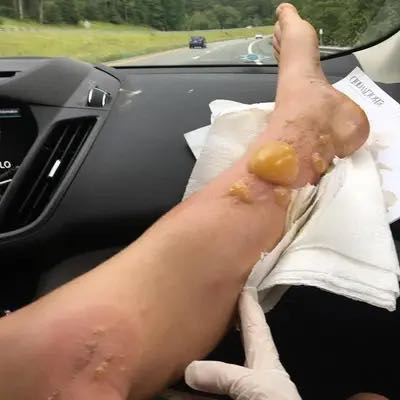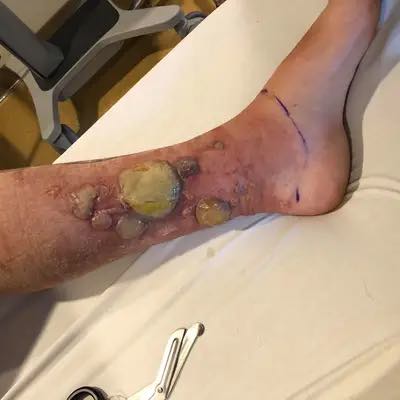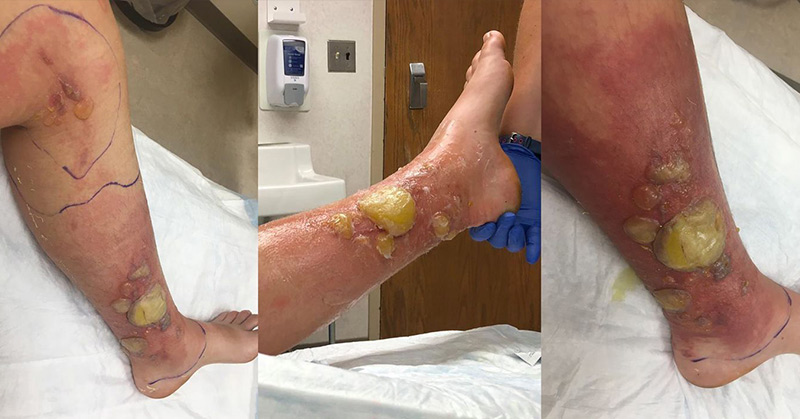This article was originally published on September 11, 2019, and has since been updated.
Nothing beats walking in nature, especially in the autumn when the summer heat has blown over and the leaves are changing colors. Although this is the perfect time to enjoy the outdoors, hikers and nature lovers should be aware of certain dangerous plants. Many people are familiar with poison ivy or poison oak but there are others that deserve just as much attention.
One such hazardous species is wild parsnip (Pastinaca sativa). Sounds harmless, but this plant caused a second-degree chemical burn on a woman’s leg after she unknowingly came into contact with it while walking on the roadside.
Warning Against the Wild Parsnip
Charlotte Murphy from Essex, Vermont, broke out in large, yellow blisters on her leg after about a week after the initial contact. She accidentally brushed past it, oblivious to what it was, a few broken leaves came into contact with her legs, leaving an unnoticeable potentially toxic sap.

She spent the rest of that day out in the summer sun, and unfortunately, due to the photosensitizing properties of the sap, a reaction began to slowly occur. After a couple of days, a few bumps appeared on her legs, but she didn’t pay much attention to them since they didn’t itch or hurt.
“I continued working out in the sun allowing more sweat and UV rays to hit the skin,” said Murphy in a viral Facebook post, “making the reaction that came a week later much worse than if I had washed my skin right away and stayed out of the sun.”
After a week from the original contact, the redness around the bumps increased and began to itch. Murphy scratched her legs in her sleep and woke up with severe blisters on her legs. They grew as the day progressed until her legs became too swollen for her to walk.


She rushed to an emergency clinic regularly for the next few days to monitor the rash and to re-bandage it. The swelling began to spread to her other leg, arms, and fingers. Murphy describes the progress as slow and got treatment from the University of Vermont’s Trauma and Burn Center. The blisters were comparable to a second-degree chemical burn.
Murphy posted her story on Facebook to warn others about the wild parsnip and the terrible effects of its oil. The story has been shared over 84,000 times.
She writes, “My hope in posting this unfortunate news is to create greater awareness for what WILD PARSNIP is…and the terrible things the OIL from its stem, leaves, and blooms can do to the skin (I’m not saying everyone will have the reaction I did) and to encourage people to spread the news.” [2]
Fortunately, she has since made a full recovery.
About the Wild Parsnip and How to Avoid It
The wild parsnip (Pastinaca sativa), also known as poison parsnip, is a member of the carrot and parsley family. Some may mistake it for a yellow-flowered Queen Anne’s Lace (Daucus carota) or Giant Hogweed (Heracleum mantegazzianum). It produces sap with chemicals that can cause the skin to burn, blister, break out in a rash, and discolor when it’s exposed to sunlight, this reaction is known as chemical photosensitization. This is not an allergic reaction; it’s a chemical burn. The wild parsnip commonly found along roadsides, in pastures, and abandoned fields.
“If your skin comes in contact with the sap or the juice in the plant your skin can develop almost a sunburn when your skin is out in the sun,” said Sarah Vose, of Vermont’s Department of Health.
If you do come into contact with this plant, wash your skin with soap and water and protect the area from sun exposure for the next 48 hours. If the area breaks out in a burn and blisters, cover the affected area with a cool, damp cloth to soothe the pain. Keep the skin out of sunlight prevent further burns. In the case of severe blistering, see a doctor immediately.
The wild parsnip can be identified by the following signs:
- Grows up to 1.5 meters tall in height
- Single stems are two to five centimeters thick and smooth
- It’s compound leaves have sharply-edged leaflets that resemble mittens
- Yellow flowers that form umbrella-like clusters 10–20 centimeters across [3]
If there are a few clusters of wild parsnip growing in your yard, they can be removed without professional assistance. Large infestations require an exterminator and repeated treatments over a period of several years.
If you do the removal yourself, ensure you are wearing protective clothing, including waterproof gloves, long sleeves, pants, and eye protection. It’s ideal to wear a disposable spray suit over your clothing. After dealing with the infestation, remove the protective clothes while avoiding any contact with sap particles on your skin. Wash your gloves with soap and water before taking off the spray suit. Wash the gloves again, then remove them, followed by your eyewear. Place the non-disposable clothing in the washing machine and wash your body immediately with soap and water.
New infestations should be removed while the plants are small. Avoid mowing areas with wild parsnip when seeds are present since the machinery can spread the seeds to new grounds. Clean mowing equipment after mowing an area with parsnip plants. You may need to mow the area several times before the plants are fully removed.
For few plants, use a shovel or your hand to cut the root one inch below the ground. This measure should be done before the plant begins to seed. If it already began to seed, cut the top with clippers and bag the seed heads until they rot. [4]
Here’s to healthy and safe fall!
For an even more detailed look at Wild Parsnip check out this document produced by The Invasive Species Center, The Ontario Invasive Plant Council, and the Ontario Provincial Government in Canada.
Keep Reading: I Almost Died From Toxic Shock Syndrome and It Had Nothing to Do With a Tampon
Sources:
- Ontario.ca Wild Parsnip. https://www.ontario.ca/page/wild-parsnip November 22, 2018
- NYIS. Wild Parsnip. https://nyis.info/invasive_species/wild-parsnip/ July 5, 2019
- “A 21-Year-Old Suffered Second-Degree Burns From A Wild Parsnip Plant” Buzzfeed News. July 2018

